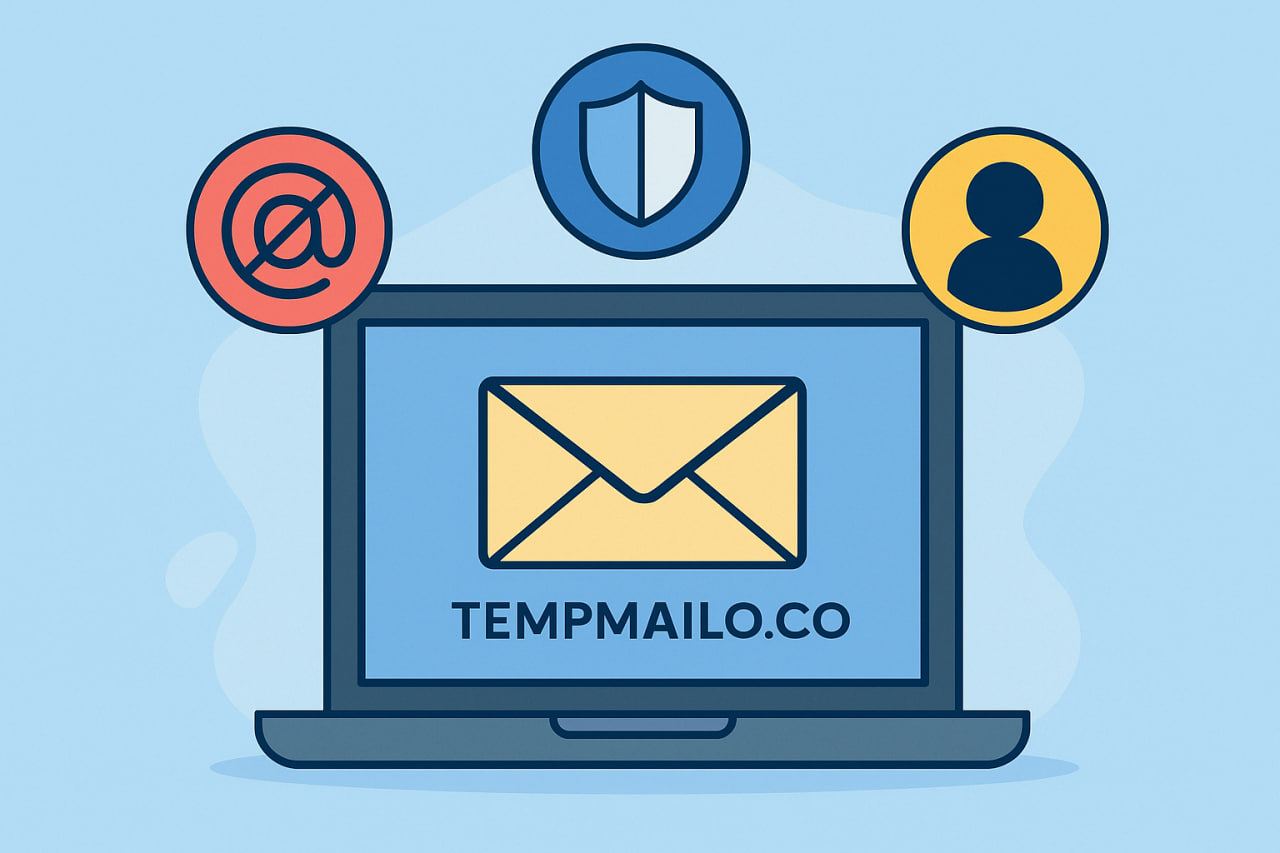In an age where nearly every website asks for your email, the simple act of “signing up” has become a privacy risk. From online stores and forums to newsletters and app trials, our inboxes are constantly under siege. The result? Endless spam, security threats, and a lack of control over who has access to your personal data.
Every time you give away your primary email address, you expose yourself to marketing databases, tracking systems, and even cybercriminals. Even seemingly trustworthy platforms have suffered data breaches in recent years, leaking millions of email addresses and sensitive information into the hands of attackers.
Temporary email services offer an elegant, no-hassle solution. With just one click, you can create a disposable email address that protects your real inbox while letting you complete any required registration or download. This empowers you to explore the internet freely — without compromising your digital privacy.
In this guide, we’ll break down how temporary emails work, why they’ve become essential tools in the fight against spam and surveillance, and how you can start using one today in under a minute.
What Is a Temporary Email?
A temporary email — also known as a disposable email address — is an inbox created for short-term use, typically lasting from 10 minutes to a few hours. These email addresses are generated instantly and can receive emails just like a regular account, but they do not require any sign-up, password, or personal details.
These services are designed for one-way communication: you can receive messages, links, confirmation codes, or attachments, but you usually cannot send emails. The point is simple — anonymity, convenience, and minimal digital footprint. Once your session ends or the timer runs out, the email address and its contents are automatically deleted.
Let’s say you want to access a free resource — an eBook, checklist, or tool. Most sites will ask for your email address in exchange. Instead of using your personal account (and risking spam later), you can generate a temporary address on a site like TempMailo.co, paste it into the form, and receive the download link or access key instantly.
It’s like a digital cloak — shielding your real identity from sites that don’t need it, and giving you back control over your own inbox.
The Problem with Using Your Real Email Everywhere
Spam Overload
One of the biggest issues with using your real email address across multiple platforms is the inevitable buildup of spam. Promotional emails, newsletters you didn’t really want, and unsolicited offers can quickly bury the important messages you actually need. Unsubscribing helps — but only to a point. Some spammy sites don’t honor unsubscribe requests, or worse, they sell your email to other marketers.
Over time, this leads to a bloated, disorganized inbox that wastes your time and attention. Even email filters can’t catch everything. Temporary emails prevent this problem entirely by keeping junk mail out of your personal space from the start.
Phishing Risks
Cybercriminals frequently use email to deliver phishing scams — fake messages that try to trick you into giving up sensitive information like passwords, bank details, or account access. These messages often appear to come from real companies and include links to malicious websites.
The more your email circulates online, the higher the chance it will end up on lists used for phishing campaigns. By using temporary emails for risky or unknown websites, you keep your primary inbox — and your identity — out of harm’s way.
Data Breaches
Even legitimate, secure websites can become victims of data breaches. From small blogs to major corporations, no one is immune. When your email is part of a leaked database, it can end up on the dark web, used for spam, fraud, and identity theft attempts. If your real email is tied to multiple accounts, one breach can expose everything.
Using a temporary email as a buffer is a smart way to limit the damage. Even if a temp email address is compromised, it’s already expired — and no longer linked to your identity.
Lack of Anonymity
When you enter your personal email on a website, you’re giving more than just contact information. Most modern websites track user behavior using cookies, pixels, and hidden analytics scripts — all tied back to your email. This creates a detailed profile of your habits, interests, and even your location.
Using a temporary email helps decouple your browsing behavior from your identity. It’s a small but powerful step toward reclaiming your anonymity online — especially when paired with tools like private browsers or VPNs.
Why Use a Temporary Email? Key Benefits
Protect Your Privacy
One of the biggest advantages of using a temporary email is its ability to safeguard your privacy. Unlike your personal or work email, which often includes your name or is linked to your online identity, temporary emails require no registration or personal details. They are anonymous by default. This means you can browse, register, and download without creating a trail back to your real identity.
This is particularly important when dealing with unknown platforms, testing new tools, or entering giveaways and promotions that might share your contact details with advertisers. With a temp email, you remain in control of who contacts you — and who doesn’t.
Avoid Spam and Junk Mail
Spam is more than an inconvenience. Over time, a spam-ridden inbox becomes harder to manage, and important emails can get lost in the clutter. While spam filters help, they’re not perfect. And once your email is on a spammer’s list, it’s nearly impossible to remove it completely.
By using a temporary email for one-time actions — such as newsletter signups, free trials, or downloads — you ensure that any marketing emails go to a disposable inbox, not your primary one. When you’re done, the temp inbox disappears — taking the spam with it.
Fast and Convenient
Creating a temporary email takes seconds. Just visit a service like TempMailo, and you instantly receive a usable email address. There’s no need to fill out forms, confirm passwords, or wait for verification. It’s as plug-and-play as it gets.
Whether you’re on a mobile device or desktop, these inboxes work in-browser and update in real-time. That makes them perfect for when you’re in a hurry or multitasking and don’t want to deal with lengthy account creation processes.
Great for Testing and One-Time Use
If you’re a developer, marketer, or QA tester, temp emails are indispensable tools for testing user registration flows, email automations, and onboarding funnels. Need to see what a user receives after signing up? Generate a temp email, complete the form, and check the inbox instantly.
They’re also useful when you want to register for an event, download a file, or gain access to gated content — just once. Rather than clogging your main inbox, you complete the task anonymously and move on.
Reduce Your Digital Footprint
Every email you give out becomes part of your digital footprint. That footprint can be tracked, mined, and sold — often without your consent. Reducing that exposure is an important part of digital hygiene.
By using disposable emails for low-risk or short-term interactions, you compartmentalize your online activity. This not only protects your privacy, but also helps you manage your communications more effectively. Use your personal email only when necessary, and keep the rest clean and ephemeral.
How to Use a Temporary Email in 30 Seconds
Using a temporary email is refreshingly simple. Here’s a quick step-by-step guide to get started:
- Visit a temporary email provider – Go to TempMailo.co. The homepage will instantly generate a disposable email address for you without any sign-up.
- Copy the address – Use the copy button or manually highlight and copy the email. It’s ready to use immediately.
- Paste it where required – Enter the temp email in any sign-up form, download page, or trial access screen where an email is required.
- Wait for the message – Return to the TempMailo inbox tab and wait a few seconds. Emails will appear in real time as soon as they are sent.
- Take action, then close it – Click the confirmation link, download the file, or complete your task. Once you’re done, you can safely close the page. The inbox — and all its data — will auto-delete shortly after.
That’s it — no account creation, no password, no tracking. Just instant, anonymous access to whatever you need. The whole process takes under a minute.
Smart Ways to Use Temporary Emails
Temporary emails are more versatile than many people realize. Here are some common — and smart — use cases where they shine:
- 🔐 Testing websites or app registration forms – Developers and product managers often need to test user flows, sign-up emails, and transactional messages. Temp emails let you do this without creating a clutter of accounts or inboxes.
- 🧠 Signing up for free resources – Download whitepapers, checklists, templates, or gated PDFs without giving your personal email to every marketing funnel you encounter.
- 📥 Accessing one-time downloads or coupons – Promo codes, digital assets, or onboarding instructions often come via email. Use a temp address to collect them — and avoid long-term spam.
- 👨💻 Joining forums or communities – Sometimes you want to post or browse anonymously in online communities without using your personal email. Temp emails give you that flexibility.
- 🎯 Running A/B tests on sign-up flows – Marketers can quickly generate test leads to verify if emails are sending properly or if forms behave as expected across different conditions.
- 🎁 Claiming promo codes or bonus content – Some deals are one-time access, and using multiple temp emails allows you to explore offers across different platforms without cluttering your main inbox.
In short: if a website only needs your email for a short-term task, you probably don’t need to hand over your real one. Temp emails offer a clean, secure workaround that simplifies your online experience without compromising your privacy.
Real Stats: The Growing Demand for Disposable Emails
Disposable email usage has surged in recent years, fueled by growing concerns over online privacy, data breaches, and digital overload. This is not just a fringe tool for developers or cybersecurity experts — it’s becoming mainstream.
According to a 2024 Statista survey:
- Over 1 in 5 internet users under the age of 35 reported using a temporary email at least once in the past year.
- More than 45% of all global emails sent daily are classified as spam — a significant increase from previous years.
- Phishing attacks via email rose by 61% year-over-year, with most targeting personal inboxes exposed during signups.
Furthermore, digital rights organizations like the Electronic Frontier Foundation (EFF) and privacy advocates routinely recommend the use of disposable emails as part of a broader strategy for online anonymity and data minimization.
Businesses are taking note too. SaaS developers, marketing teams, and QA testers now incorporate temp emails into their daily workflows to streamline testing, avoid pollution of CRM systems, and simulate user signups without cluttering live databases.
In short, temporary email usage is no longer a novelty — it’s a smart response to a growing digital problem. As awareness increases, so too does the demand for fast, reliable, and privacy-focused tools like TempMailo.
Frequently Asked Questions (FAQ)
1. Are temporary emails legal?
Yes, using a temporary email address is completely legal in most countries. They’re designed to enhance privacy and reduce spam, and are widely used by developers, testers, and privacy-conscious users. However, using them to impersonate someone or commit fraud is illegal and unethical.
2. Can I receive attachments or HTML emails in a temporary inbox?
Most high-quality temporary email services — including TempMailo — support HTML rendering and basic attachments like images or PDFs. However, for large files or sensitive documents, it’s safer to use secure alternatives.
3. Will I be able to access the inbox later?
No. Most temp email addresses are deleted after a certain time (usually between 10 minutes and a few hours). Once deleted, all contents are gone permanently. If you need recurring access, consider using an alias or redirect-based system instead.
4. Can websites detect that I’m using a disposable email?
Some websites maintain blacklists of popular temporary email domains. If your temp address is blocked, you can often refresh or generate a new one. Alternatively, switching services or using a lesser-known provider often bypasses these filters.
5. What’s the difference between temporary emails and aliases?
Temporary emails are short-lived, anonymous inboxes designed for one-time use. Aliases are long-term redirect addresses linked to your main inbox. While both hide your real email, aliases are better for managing long-term communication, while temp emails are better for short-term anonymity and spam prevention.
Conclusion
In a digital world where privacy is constantly under threat, temporary emails offer a simple, effective line of defense. They let you take back control over who gets access to your inbox, without sacrificing convenience or wasting time.
Whether you’re signing up for a free trial, testing a product, accessing gated content, or just avoiding spam — temp emails help you keep your personal information personal. They’re fast, free, and incredibly effective at reducing digital noise.
Ready to clean up your inbox and browse with confidence? Try TempMailo today — and experience the internet on your terms.





